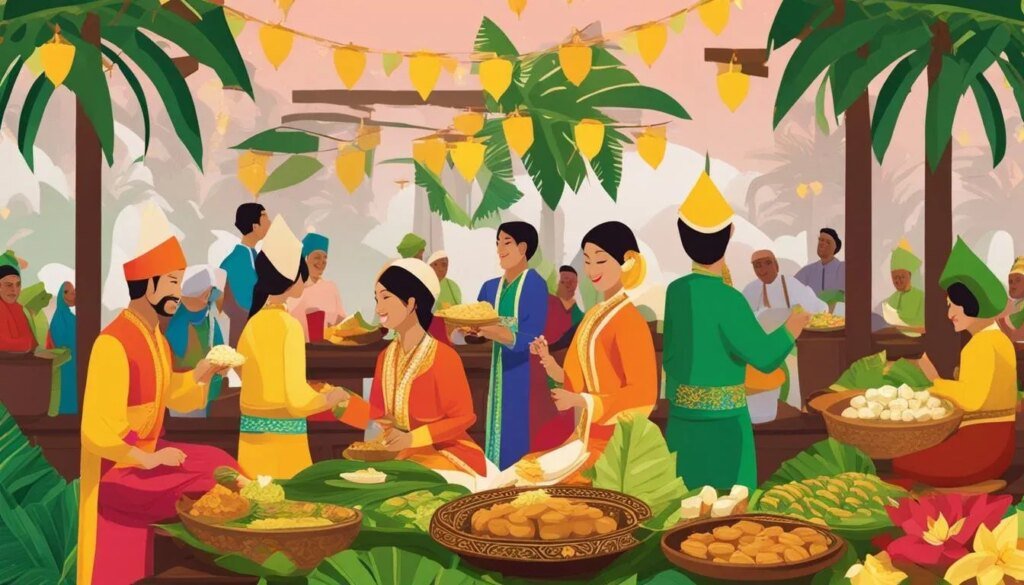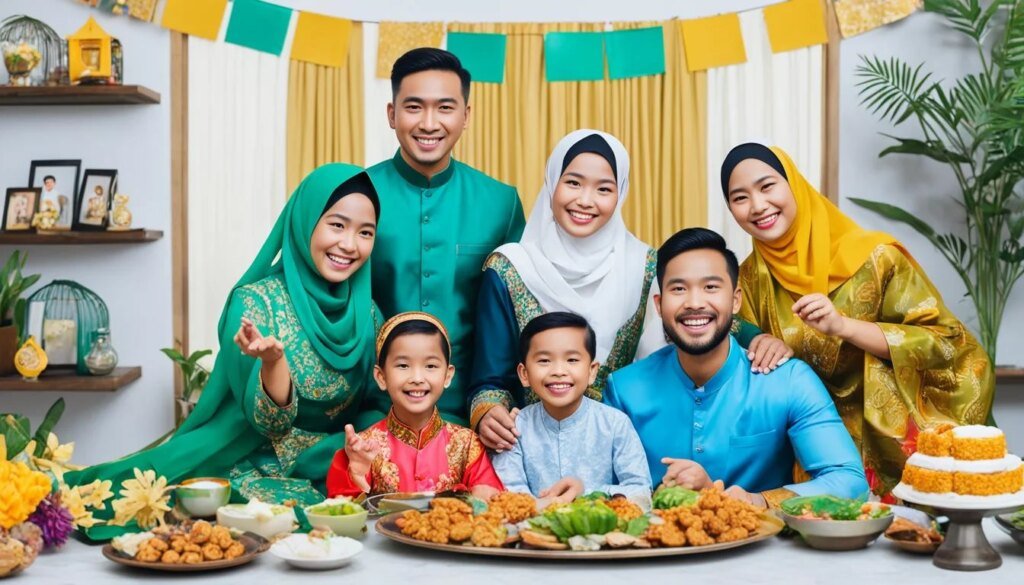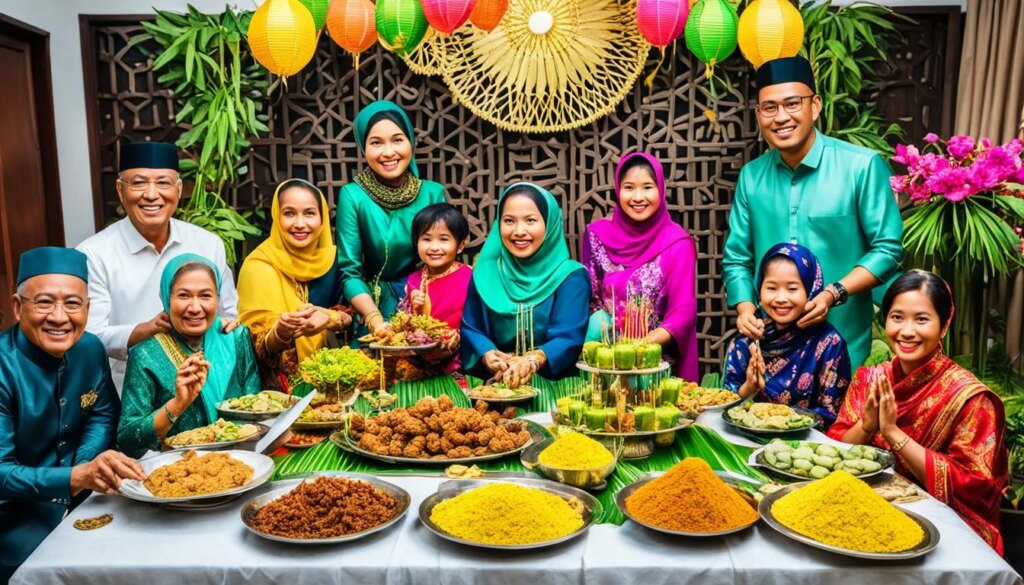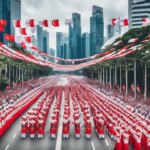Hari Raya Aidilfitri, also known as Hari Raya Puasa, is a joyous Muslim festival celebrated in Malaysia to mark the end of the holy month of Ramadan. This vibrant cultural celebration holds great significance to the Muslim community in Malaysia and is a time of joy, gratitude, and family gatherings.
Key Takeaways:
- Hari Raya Aidilfitri is a Muslim festive celebration that marks the end of Ramadan in Malaysia.
- It is a time of joy, gratitude, and family gatherings.
- The festival is known for its vibrant customs, open houses, and delicious food.
- Hari Raya Aidilfitri is a significant cultural celebration in Malaysia, showcasing the rich traditions and customs of the country.
- Despite the challenges posed by the pandemic, Malaysians continue to find ways to celebrate while prioritizing safety.
Customs and Traditions of Hari Raya Aidilfitri
During Hari Raya Aidilfitri, Muslims in Malaysia partake in a range of customs and traditions, adding to the festive spirit and cultural significance of the celebration.
The festival commences with an early morning prayer at the mosque, where communities gather to seek blessings and express gratitude. This prayer, known as “Solat Sunat Hari Raya,” sets the tone for the day’s festivities and reinforces the spiritual significance of Hari Raya Aidilfitri.
Seeking forgiveness from elders is another integral part of the tradition. Younger family members visit their parents, grandparents, and relatives, seeking sincere apologies and resolving any misunderstandings. This act of seeking forgiveness promotes reconciliation and strengthens familial bonds.
One of the most cherished customs during Hari Raya Aidilfitri is the distribution of “duit raya” or money packets. Adults hand out these festive packets to children, symbolizing blessings, prosperity, and goodwill. It brings joy to the young ones and represents the spirit of generosity and unity that permeates the festival.
Families also pay tribute to their departed loved ones during this time. They visit the graves of ancestors, offering prayers and paying respects. Lighting oil lamps, known as “pelita,” is a common practice, signifying the guiding light of memories and remembrance.
Traditional Malay clothing plays a significant role in Hari Raya Aidilfitri. In Malaysia, the popular attire for women is the “baju kurung,” a loose-fitting blouse and a long skirt, while men often wear the “baju Melayu,” a loose-fitting shirt with trousers. These traditional garments symbolize unity, cultural pride, and adherence to the customs of the festival.
Open houses are another prominent tradition during Hari Raya Aidilfitri, which exemplify the warm Malaysian hospitality and spirit of togetherness. Malaysians of diverse backgrounds and faiths are invited to these gatherings to enjoy the festive atmosphere and partake in traditional delicacies.
Food is an essential aspect of Hari Raya Aidilfitri, with various dishes prepared to delight the taste buds. Some popular delicacies include “ketupat,” a compressed rice cake wrapped in coconut leaves, “beef rendang,” a flavorful and spicy curry, “lemang,” glutinous rice cooked in bamboo, and “satay,” skewered and grilled meat accompanied by a peanut sauce. These mouthwatering treats represent the culinary richness and cultural diversity of Malaysia.
Significance of Hari Raya Aidilfitri
Hari Raya Aidilfitri holds great significance to the Muslim community in Malaysia as it is a celebration of faith and gratitude. The festival marks the end of a month-long period of fasting and self-discipline during Ramadan. It is a time for Muslims to reflect upon their spiritual journey, seek forgiveness, and strengthen family and community ties. Hari Raya Aidilfitri is not only a religious observance but also a cultural festivity that showcases the rich traditions and customs of Malaysia.
During the month of Ramadan, Muslims abstain from food, drink, smoking, and other indulgences from sunrise to sunset. This period of fasting is a significant act of self-discipline and devotion to their faith. Hari Raya Aidilfitri serves as a celebration of the successful completion of this fasting period, representing a sense of achievement, purification, and renewal.
Moreover, Hari Raya Aidilfitri is a time of expressing gratitude for the blessings received and extending these blessings to others. Muslims take the opportunity to visit family, friends, and neighbors, sharing meals and exchanging heartfelt greetings. It is a time for unity, forgiveness, and strengthening relationships within the community.
Eid al-Fitr, as Hari Raya Aidilfitri is also known, is not just a religious holiday; it is a cultural festivity that brings Malaysians from diverse backgrounds together. The celebration transcends religious boundaries, showcasing the harmonious coexistence of various cultures in Malaysia. During Hari Raya Aidilfitri, people of different ethnicities and religions are invited to join in the festivities, further promoting understanding, unity, and respect.
Hari Raya Aidilfitri Celebrations in Malaysia
In Malaysia, Hari Raya Aidilfitri is celebrated with great enthusiasm and is considered a major public holiday. The festivities extend beyond the first day of the festival, allowing Malaysians to enjoy an extended celebration of this significant religious occasion.
During Hari Raya Aidilfitri, many Malaysians take advantage of the public holiday to return to their hometowns, a practice known as “balik kampung”. This tradition allows families and friends to reunite, fostering a sense of togetherness and strengthening bonds. As people embark on their journeys, the cities become quieter, reflecting the anticipation and excitement of the homecoming.
One of the most cherished customs of Hari Raya Aidilfitri in Malaysia is the open house tradition. Malaysians, regardless of their race or background, open their doors to invite others to share in the joyous celebrations. This inclusivity and warmth exemplify the multicultural fabric of Malaysia, where diverse communities come together to celebrate unity and friendship.
Throughout the festive season, Malaysians indulge in delicious traditional delicacies such as ketupat, rendang, lemang, and satay. These mouthwatering dishes are prepared with love and care, adding to the festive atmosphere and delighting the taste buds of guests.
Hari Raya Aidilfitri celebrations play a significant role in showcasing the rich cultures and festivals that make Malaysia unique. The festival is a testament to Malaysia’s commitment to preserving its heritage while embracing diversity.
To give you a glimpse of the vibrant atmosphere of Hari Raya Aidilfitri in Malaysia, here is a beautiful image that captures the essence of this joyous celebration:

Through the celebration of Hari Raya Aidilfitri, Malaysia shines a light on its cultural tapestry and captivates visitors with its warmth and hospitality. The festival embraces the values of unity, gratitude, and togetherness, creating an unforgettable experience for all who partake in its festivities.
| Key Aspects of Hari Raya Aidilfitri Celebrations in Malaysia | Description |
|---|---|
| Open House Tradition | Welcoming Malaysians of all backgrounds to celebrate together and enjoy traditional delicacies. |
| “Balik Kampung” | The practice of returning to one’s hometown to reunite with family and friends. |
| Extended Festivities | Celebrations beyond the first day of the festival, allowing for a more immersive experience. |
| Cultural Showcase | Emphasizing the diverse cultures and festivals that contribute to Malaysia’s vibrant identity. |
The Hari Raya Aidilfitri celebrations in Malaysia embody the spirit of unity, cultural diversity, and heartfelt hospitality. It is a time when Malaysians come together to celebrate their shared values and create lasting memories.
History of Hari Raya Aidilfitri
The history of Hari Raya Aidilfitri dates back to the Islamic prophet Muhammad, who introduced the festival upon his migration to Mecca. Since the 15th century, when Islam firmly established itself in the region, this Islamic festival has been celebrated with great pomp and valor. Over time, it has become one of the major festivals observed by Muslims worldwide, including in Malaysia.
Celebrating Hari Raya Aidilfitri in the “New Norm”
Due to the COVID-19 pandemic, the celebrations of Hari Raya Aidilfitri in Malaysia have been impacted. The implementation of Movement Control Orders and restrictions on travel and gatherings have changed the traditional norms of the festival.
Malaysians have had to adapt and find new ways to celebrate while adhering to safety measures. Balik kampung (return to the village) travels and large open houses have been limited to ensure public safety and prevent the spread of the virus.
However, the spirit of Hari Raya Aidilfitri perseveres, and Malaysians have embraced a new style of celebration. Rather than traveling far, families have chosen to visit neighbors and relatives within the same state, allowing them to connect and share the joy of the festival while staying close to home.
“Although we can’t celebrate Hari Raya as usual, it’s important to prioritize the safety of our loved ones. We can still create a joyful and lively atmosphere by visiting nearby family and friends, exchanging well-wishes, and embracing the spirit of togetherness,” said Ahmad, a resident of Kuala Lumpur.
Additionally, festive broadcasts have played a significant role in this new style of celebration. Malaysians have tuned in to televised programs showcasing traditional performances, cultural exhibitions, and religious sermons to capture the essence of the festival from the comfort of their homes.
While the pandemic has brought challenges, it has also fostered creativity and resilience within the Malaysian community. Despite the restrictions, the celebration of Hari Raya Aidilfitri continues, showcasing the adaptability and unity of Malaysians in the face of adversity.
Image related to Celebrating Hari Raya Aidilfitri in the “New Norm”

Hari Raya Aidilfitri Traditions and Activities
Hari Raya Aidilfitri, also known as Eid al-Fitr, is a time of joyous celebrations for Muslims in Malaysia. This yearly festival brings together family and friends to partake in various traditions and activities that have been passed down through generations.
Praying and Thanking the Almighty
One of the most important aspects of Hari Raya Aidilfitri is expressing gratitude and seeking blessings from the Almighty. Muslims start the day by performing special prayers at the mosque, expressing their thanks for completing the holy month of Ramadan and seeking forgiveness.
Wearing Traditional Outfit
During Hari Raya Aidilfitri, Malaysians don traditional clothing to celebrate the occasion. Women typically wear the colorful and elegant attire called “baju kurung,” while men opt for the classic “baju Melayu.” These traditional outfits reflect the cultural heritage of Malaysia and add a sense of grandeur to the festivities.
Preparing Excellent Cuisine
A highlight of Hari Raya Aidilfitri is the mouthwatering cuisine prepared for open houses and gatherings. Families spend days cooking and baking an array of delectable dishes that include local delicacies such as beef rendang, ketupat, lemang, and satay. The art of preparing these dishes is passed down from one generation to another, making the cuisine an essential part of the festival’s identity.
Exchanging Green Packets
One cherished tradition during Hari Raya Aidilfitri is the exchange of “duit raya,” or green packets. These small envelopes contain money and are given to children, family members, and even close friends as a gesture of goodwill and blessings. It is customary to give and receive these green packets, symbolizing prosperity and good fortune.
Making Kuih
Kuih, a type of traditional Malay cookie or tart, holds a special place during Hari Raya Aidilfitri. Families come together to make various types of kuih, such as kuih tart, kuih lapis, and ondeh-ondeh. These delectable treats are served to guests during open houses and are also shared with neighbors and friends as a way of fostering community spirit.
Household Decorations
Hari Raya Aidilfitri is a time when homes across Malaysia are beautifully decorated to welcome guests and create a festive atmosphere. Lights, colorful ribbons, and ketupat-shaped decors adorn the houses, enhancing the joyous spirit of the occasion. These decorations reflect the cultural significance and unity experienced during this special time.
Festive Songs
The air is filled with joyful melodies during Hari Raya Aidilfitri, as festive songs play an integral role in the celebrations. Traditional songs known as “yusuf” and “selamat hari raya” resonate throughout homes and communities, spreading happiness and fostering a sense of togetherness.
In summary, Hari Raya Aidilfitri in Malaysia showcases a rich tapestry of traditions and activities. From prayers and wearing traditional outfits to preparing delicious cuisine, exchanging green packets, making kuih, decorating homes, and embracing festive songs, this vibrant festival brings Malaysians together in gratitude, harmony, and celebration.
Conclusion
Hari Raya Aidilfitri is a vibrant and significant festival celebrated by Muslims in Malaysia to mark the end of the holy month of Ramadan. This joyful occasion is filled with customs, traditions, and a sense of unity among Malaysians of diverse backgrounds.
Despite the challenges posed by the COVID-19 pandemic, Malaysians have adapted their celebrations to prioritize safety while still embracing the festive spirit. While traditional activities such as balik kampung and open houses may be limited, Malaysians are finding creative ways to connect with loved ones and celebrate the festival, such as through virtual gatherings and festive broadcasts.
Hari Raya Aidilfitri serves as a reminder of the importance of family, forgiveness, and gratitude. It showcases the rich cultural heritage of Malaysia, and the festivities bring together people from all walks of life, fostering unity and harmony within the community.
In conclusion, Hari Raya Aidilfitri in Malaysia is an occasion that celebrates faith, joy, and cultural diversity. It is a time when Muslims come together to reflect on their spiritual journey and strengthen their bonds with family and friends. Despite the changing circumstances, Malaysians continue to embrace the spirit of the festival and find innovative ways to celebrate. Hari Raya Aidilfitri truly embodies the essence of Malaysia’s cultural traditions, making it a cherished and significant holiday in the country.



